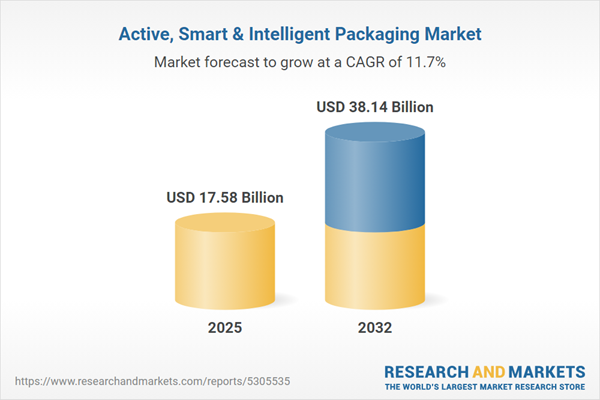Speak directly to the analyst to clarify any post sales queries you may have.
The Active, Smart & Intelligent Packaging Market is evolving rapidly, driven by innovations in sensor integration, connectivity, and material science. As packaging technology advances, organizations across sectors are leveraging these developments to improve product protection and operational efficiency throughout global supply chains.
Market Snapshot: Growth Trajectory of the Active, Smart & Intelligent Packaging Market
The Active, Smart & Intelligent Packaging Market grew from USD 15.76 billion in 2024 to USD 17.58 billion in 2025. It is expected to continue growing at a CAGR of 11.68%, reaching USD 38.14 billion by 2032. This robust expansion reflects sustained adoption across a variety of industries as organizations respond to changing regulatory landscapes, surging demand for transparency, and evolving supply chain requirements.
Scope & Segmentation Across Technologies and Industries
- Material Types: Includes glass for purity-centric use cases; aluminum and steel for protection and recyclability; corrugated board, folding cartons, and kraft paper for sustainability and sensor integration; polyethylene, polyethylene terephthalate, and polypropylene for advanced film applications.
- Packaging Formats: Covers flexible packaging such as bags, films, sheets, and pouches for waste reduction and smart label integration; and rigid packaging such as bottles, jars, cans, tins, trays, and containers supporting mechanical stability and embedded sensing.
- End-Use Industries: Ranges from automotive and industrial to consumer electronics—including computers, home entertainment, smartphones, and wearables—food and beverage (alcoholic and non-alcoholic, dairy, meat and poultry, packaged foods), personal care and cosmetics, and pharmaceuticals (medical devices, nutraceuticals, over-the-counter and prescription drugs).
- Distribution Channels: Comprises convenience stores that prioritize clear authenticity markers, online retail leveraging integrated tracking for reduced returns, specialty stores using premium smart packaging, and supermarkets and hypermarkets requiring scale with quality assurance.
- Regional Coverage: Spans North America, Latin America, Europe, Middle East, Africa, and Asia-Pacific, encompassing both innovation-driven and production-oriented markets.
Key Takeaways: Strategic Insights for Decision-Makers
- Emerging technologies now allow packaging to actively monitor and respond to environmental changes, improving product life-cycle management and brand integrity.
- Smart systems integrate sensor arrays, edge computing, and connectivity solutions to facilitate real-time product tracking and data-driven risk mitigation across supply chains.
- Material advancements, such as nanomaterials with antimicrobial features and additive-enhanced polymers, drive reductions in spoilage and support compliance with stringent regulations.
- Collaboration between technology firms, packaging converters, and academic institutions accelerates the development of interoperable and secure packaging solutions tailored to diverse industries.
- Regional strategies must account for regulatory variations, consumer expectations regarding transparency, and the unique logistics ecosystems across global markets.
Assessing Tariff Impact on Packaging Innovation
United States tariff adjustments for 2025 impose new considerations on material sourcing and manufacturing. Increased duties on metals and polymers are shifting procurement strategies, prompting the diversification of suppliers, renegotiation of contracts, and exploration of alternative production sites. This has a direct influence on supply chain logistics and scheduling, making agility essential for maintaining competitive positioning and compliance.
Methodology & Data Sources
This report is grounded in primary interviews with senior executives from packaging, technology, and retail sectors, case studies of implemented solutions, and comprehensive secondary research from official publications and patent filings. Analytical tools include technology readiness ratings, regulatory mapping, and segment scoring based on scalability, interoperability, and environmental considerations.
Why This Report Matters for Senior Decision-Makers
- Enables informed investment decisions by detailing technological, regional, and regulatory trends shaping the packaging landscape.
- Supports competitive strategies through actionable segmentation, end-use analysis, and assessment of evolving sourcing and logistics requirements.
Conclusion: Future Trajectory of Active, Smart & Intelligent Packaging
The market’s ongoing evolution, underpinned by advances in materials, embedded sensors, and data analytics, will continue to transform product experiences and supply chain transparency. Organizations that embrace innovation and strategic alignment are well positioned to capitalize on industry growth and efficiency gains.
Additional Product Information:
- Purchase of this report includes 1 year online access with quarterly updates.
- This report can be updated on request. Please contact our Customer Experience team using the Ask a Question widget on our website.
Table of Contents
3. Executive Summary
4. Market Overview
7. Cumulative Impact of Artificial Intelligence 2025
Companies Mentioned
The companies profiled in this Active, Smart & Intelligent Packaging market report include:- Amcor plc
- Sealed Air Corporation
- Berry Global Group, Inc.
- Crown Holdings, Inc.
- Mondi plc
- Smurfit Kappa Group plc
- WestRock Company
- Tetra Pak International S.A.
- Ball Corporation
- Huhtamaki Group
- Stora Enso OYJ
Table Information
| Report Attribute | Details |
|---|---|
| No. of Pages | 196 |
| Published | November 2025 |
| Forecast Period | 2025 - 2032 |
| Estimated Market Value ( USD | $ 17.58 Billion |
| Forecasted Market Value ( USD | $ 38.14 Billion |
| Compound Annual Growth Rate | 11.6% |
| Regions Covered | Global |
| No. of Companies Mentioned | 12 |









